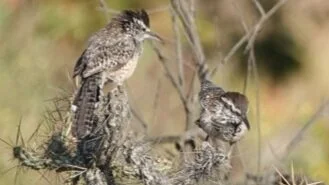The Cactus Wren is appropriately named because this large wren depends on cacti for nesting and foraging.
Lock-down Yard-Birding
OUTDOOR EDUCATION: Experience and Perspective
INTERPRETING NATURE: Making Connections Between Birding and Food Gardening
Call for submissions — Ralph W. Schreiber Ornithology Research Awards 2020
CALL FOR APPLICATIONS: The Los Angeles Audubon Society presents an annual research grant, the Ralph W. Schreiber Ornithology Research Award, to support research relevant to the biology of birds. Award recipients are limited to students and amateur ornithologists with limited or no access to major granting agencies and who reside in southern California (from San Luis Obispo, Kern and San Bernardino Counties south) or are currently enrolled in a southern California academic institution. There is no geographical restriction on the research area. Between $1500 and $5000 are awarded each year. One or more awards will be given out in 2020.
The application deadline for the 2020 Research Award is September 1, 2020; grants will be awarded in November 2020.
PHOTO ESSAY: India Journal — December 2019
The Rann of Kutch is a vast area of salt desert / salt marsh located in the north-west of the Indian State of Gujrat. It borders the Arabian sea on the west, the Indus river delta to the north and stretches east for about 250 miles. It is split into the Great Rann and the Little Rann, somewhat loosely, based on ability to access and administer the vast region. It is arguably the largest salt desert / marshland in the world, covering an area of about 10,000 sq. miles. Desert or marshland?
Birding Notes from the Ebell Club, 1917
The regular meeting of the department of California History and Landmarks [of the Ebell Club] met on April 26 [1917] …
Miss Phillipson introduced Mrs. Harriet Myers, secretary of the Audubon Society and chairman of the Department of Birds, Wildlife and Flowers of the General and State Federations [of Women’s Clubs]. Her subject was California birds.
Western Tanager, Vol. 86 No. 6, July–August 2020
The endangered Imperial Parrot | Photo by P. Reillo, RSCF, TCI/FIU.
INSIDE THIS ISSUE
WINGING IT—Discovering the Caribbean Birding Trail, Part II, Dominica — The Rare Parrots' Paradise | By Robbie Lisa Freeman
BIRDS OF THE SEASON — June 2020 | By Jon Fisher
YOUNG BIRDERS—Charismatic and Clever: The Cactus Wren (campylorhynchus brunneicapillus) | By Dessi Sieburth
OUTDOOR EDUCATION—Experience & Perspective | By Cindy Hardin
INTERPRETING NATURE—Making Connections Between Birding and Food Gardening | By Ingrid Carrillo
CONSERVATION CORNER—Rio de Los Angeles State Park Riparian Breeders | By Andy Birch
FROM OUR READERS
Top Ways To Preserve Nature While Hiking, by Rachel Gaffney
Photo Essay — India Journal: December 2019, by Rustom Jamadar
The Fledgling, by Brenda Rees
Owls Nesting in Our Yard, by Janice Rayman
Reclaiming Ourselves Through Nature, by Danny Humphrey
Two Robins in a Birdbath, by Janine Soucie Kelley
No Sparrows, by Annie Margis
Birding Notes from the Ebell Club 1917, by Judith Thompson
POEM: Ballona Stories, by Joyce Karel
FROM OUR READERS: Top Ways to Preserve Nature While Hiking
CONSERVATION CORNER: Rio de Los Angeles State Park Riparian Breeders
Once in a while, it’s good to celebrate a conservation success story on public land, right in the heart of the city. Rio de Los Angeles State Park appears to be a real success story in terms of re-wilding a small section of a park that sits within an intensely urbanized setting. The park is located in northeast Los Angeles, approximately 2.5 miles north of downtown and is located next to the former Union Pacific Rail Yard called the Taylor Yard complex, which is also under active long-term planning as a city park.










